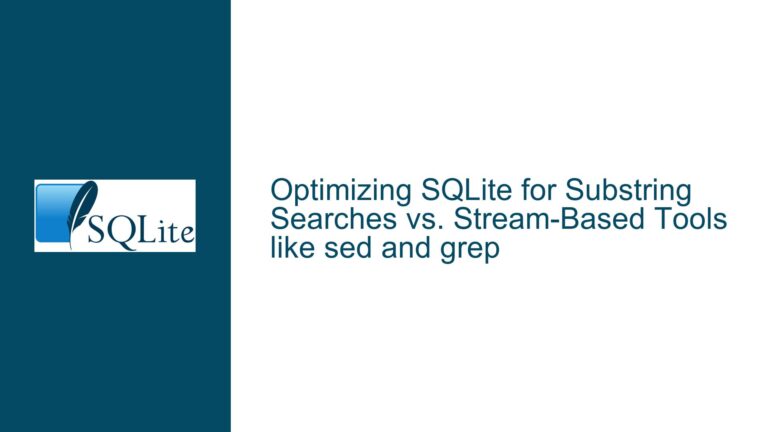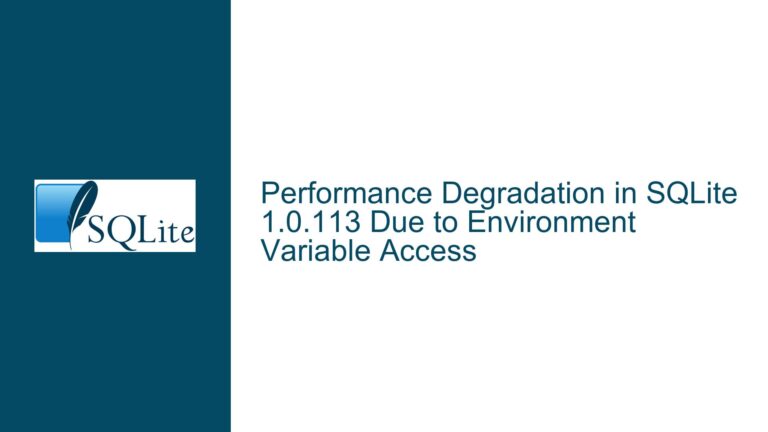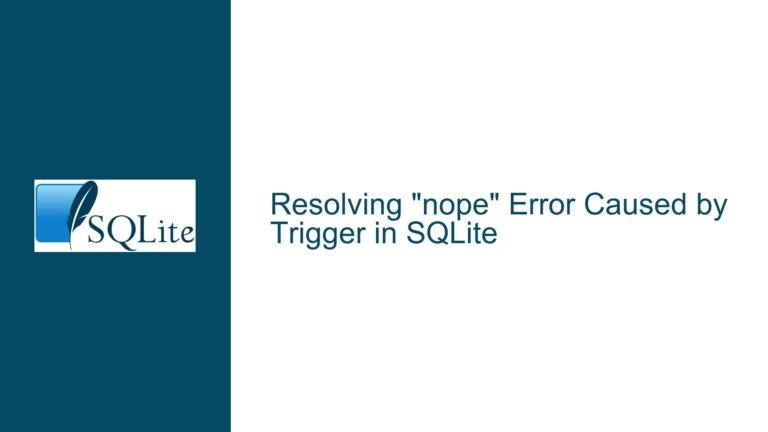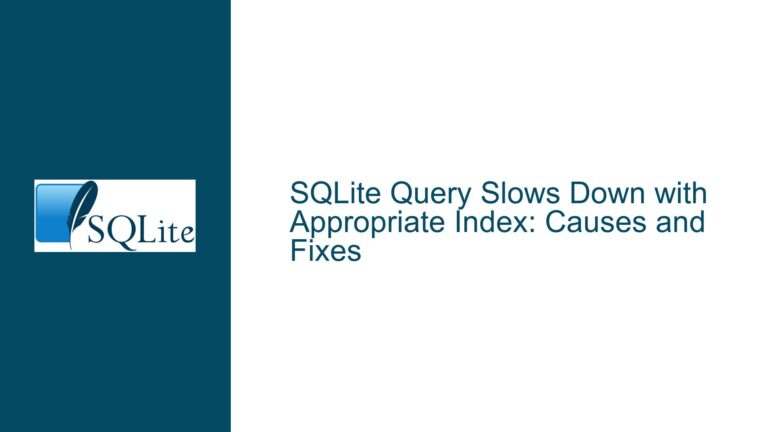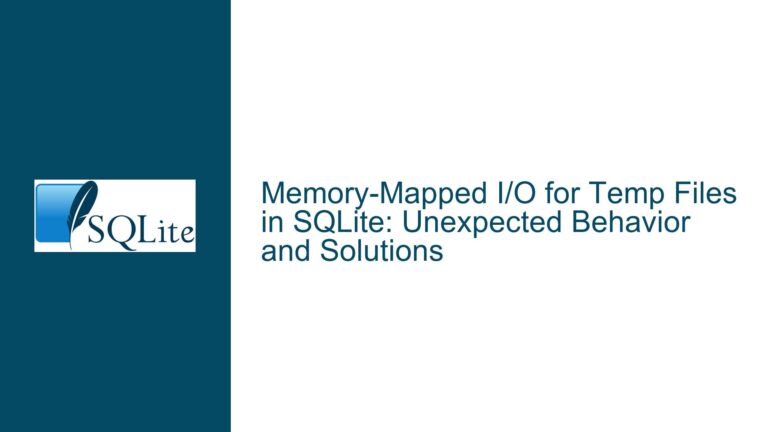Concurrency and Blocking Behavior of WAL Checkpointing in SQLite
Understanding WAL Checkpointing and Its Impact on Database Operations
WAL (Write-Ahead Logging) checkpointing is a critical operation in SQLite that ensures the integrity and performance of the database by transferring changes from the WAL file back into the main database file. This process is essential for maintaining a balance between performance and durability. However, the concurrency and blocking behavior of WAL checkpointing can significantly impact the overall performance of the database, especially in multi-threaded or high-concurrency environments.
When a WAL checkpoint is initiated, the database must decide how to handle concurrent read and write operations. The behavior of these operations depends on the type of checkpoint being performed. SQLite supports several checkpoint modes, including PASSIVE, FULL, RESTART, and TRUNCATE. Each mode has different implications for concurrency and blocking.
The PASSIVE checkpoint is the most lenient, allowing both readers and writers to continue operating concurrently with the checkpointing process. However, this mode does not guarantee that the WAL file will be truncated, which can lead to unbounded growth of the WAL file if checkpoints are not completed successfully. On the other hand, FULL, RESTART, and TRUNCATE checkpoints are more aggressive. While they ensure that the WAL file is truncated, they also block new writers from starting until the checkpoint is complete. Readers, however, are never blocked by any type of checkpoint.
Understanding these nuances is crucial for database administrators and developers who need to optimize the performance of their SQLite databases. The choice of checkpoint mode can have a significant impact on the responsiveness of the database, especially in scenarios where high concurrency is required.
Potential Issues with WAL Checkpointing in High-Concurrency Environments
In high-concurrency environments, the choice of WAL checkpointing mode can lead to several potential issues. One of the most common problems is the blocking of new writers during FULL, RESTART, or TRUNCATE checkpoints. When these checkpoints are initiated, any new write operations that attempt to start will be blocked until the checkpoint is complete. This can lead to increased latency for write operations, which may be unacceptable in applications that require low-latency responses.
Another issue that can arise is the unbounded growth of the WAL file when using PASSIVE checkpoints. Since PASSIVE checkpoints do not block writers, they are more likely to be interrupted by concurrent write operations. If a PASSIVE checkpoint is interrupted, the WAL file will not be truncated, and it may continue to grow indefinitely. This can lead to excessive disk usage and potentially degrade the performance of the database over time.
Additionally, the performance impact of WAL checkpointing can vary depending on the size of the WAL file and the amount of data that needs to be transferred back to the main database file. Larger WAL files will take longer to checkpoint, which can exacerbate the blocking issues mentioned above. In some cases, the checkpointing process itself can become a bottleneck, especially if it is performed frequently or in a high-concurrency environment.
Finally, the interaction between WAL checkpointing and other database operations, such as vacuuming or auto-vacuuming, can also lead to performance issues. For example, if a vacuum operation is running concurrently with a WAL checkpoint, the two operations may compete for resources, leading to increased latency and reduced throughput.
Strategies for Optimizing WAL Checkpointing Performance
To mitigate the potential issues associated with WAL checkpointing, several strategies can be employed. The first and most important step is to carefully choose the appropriate checkpoint mode based on the specific requirements of the application. For applications that require low-latency write operations, PASSIVE checkpoints may be the best option, despite the risk of WAL file growth. However, it is important to monitor the size of the WAL file and take corrective action if it grows too large.
One way to manage WAL file growth is to periodically perform a FULL, RESTART, or TRUNCATE checkpoint during periods of low database activity. This can help ensure that the WAL file is truncated without significantly impacting the performance of the database. Additionally, the PRAGMA wal_autocheckpoint setting can be used to automatically perform PASSIVE checkpoints at regular intervals, reducing the need for manual intervention.
Another strategy is to use a separate thread for performing WAL checkpoints. By running the checkpoint operation in a separate thread, it is possible to reduce the impact on the main database operations. However, it is important to note that this approach does not eliminate the blocking of new writers during FULL, RESTART, or TRUNCATE checkpoints. It can, however, help to ensure that the checkpointing process does not interfere with other critical database operations.
In some cases, it may be necessary to adjust the size of the WAL file or the checkpoint threshold to optimize performance. The PRAGMA wal_autocheckpoint setting can be used to control the frequency of automatic checkpoints, while the PRAGMA journal_size_limit setting can be used to limit the size of the WAL file. These settings should be carefully tuned based on the specific workload and performance requirements of the application.
Finally, it is important to monitor the performance of the database and the WAL checkpointing process on an ongoing basis. Tools such as the SQLite command-line interface (CLI) or third-party monitoring tools can be used to track the size of the WAL file, the frequency of checkpoints, and the impact of checkpointing on database performance. By continuously monitoring these metrics, it is possible to identify and address potential issues before they become critical.
In conclusion, WAL checkpointing is a powerful feature of SQLite that can significantly impact the performance and durability of the database. By understanding the concurrency and blocking behavior of different checkpoint modes, and by employing appropriate optimization strategies, it is possible to ensure that the database operates efficiently and reliably, even in high-concurrency environments.

